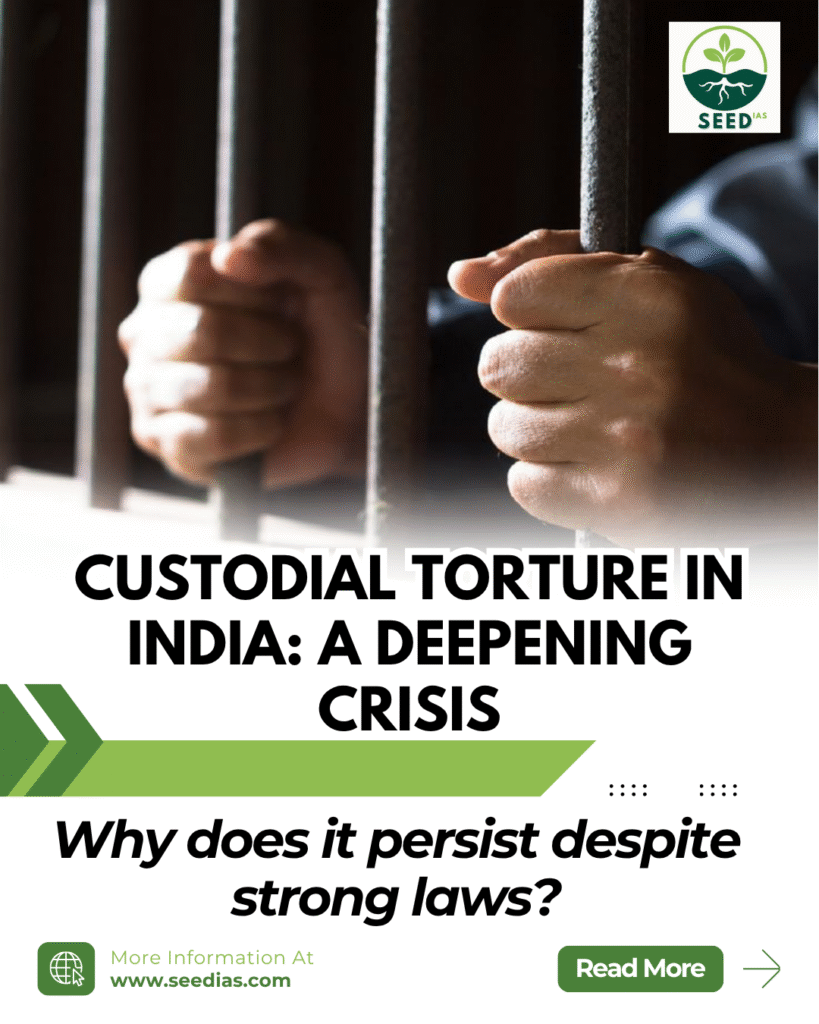Why in NEWS
A recent custodial death in Tamil Nadu has reignited national concern over custodial torture and human rights violations in police custody.
What is Custodial Torture?
| Aspect | Description |
|---|---|
| Definition | Infliction of physical or psychological suffering on individuals by authorities while in custody. |
| Physical Torture | Beatings, electric shocks, sexual abuse, suffocation, denial of medical care. |
| Psychological Torture | Threats, sleep deprivation, solitary confinement, humiliation, mock executions. |
| Purpose | Coerce confessions or information through pain or fear. |
| Impact | Frequently leads to custodial deaths, undermining rule of law. |
Custodial Torture in India: Key Data
| Parameter | Details |
|---|---|
| Custodial Deaths (2016–2022) | 11,656 across India; Uttar Pradesh (2,630), Tamil Nadu (490 – highest in South India). |
| Preventive Detention (2022) | Tamil Nadu detained 2,129 individuals—50% of India’s total. |
| Marginalized Victims | SCs formed 38.5% of victims in TN, though they are only 20% of the population. |
Constitutional and Legal Safeguards
| Provision | Protection Offered |
|---|---|
| Article 14 | Equality before law—police not above the law. |
| Article 21 | Right to life and dignity—freedom from torture. |
| Article 20(1) | No retrospective punishment. |
| Article 20(3) | Protection against self-incrimination. |
| Bharatiya Nyaya Sanhita (BNS) Sec. 120 | Punishes extraction of confession through hurt. |
| BNSS Sec. 35 | Valid, documented arrest procedures mandated. |
| BSA Sec. 22 | Confessions under coercion are inadmissible. |
International Framework
| Instrument | Key Provision |
|---|---|
| UN Charter (1945) | Dignity and rights of all individuals must be protected. |
| Universal Declaration of Human Rights (1948) | Protection from torture and cruel treatment. |
| UNCAT (1984) | Calls for criminalizing torture—India signed but has not ratified. |
Challenges in Addressing Custodial Torture
| Challenge | Explanation |
|---|---|
| No Standalone Law | Lack of specific anti-torture law weakens enforcement. |
| Impunity for Perpetrators | Almost zero convictions despite inquiries and charges. |
| Weak Human Rights Institutions | NHRC/SHRCs lack binding powers and are underfunded. |
| Prison Overcrowding | At 130% capacity—worsens abuse risk. |
| Victim Fear | Lack of legal aid, fear of retaliation discourages complaints. |
| Judicial Delay | Slow courts, weak witness protection delay justice. |
| Ignored DK Basu Guidelines | Arrest memos, medical checks often skipped. |
Key Recommendations
| Source | Suggestion |
|---|---|
| Law Commission (273rd Report, 2017) | Ratify UNCAT, enact Prevention of Torture Law. |
| Draft Bill | Submitted in 2017 but remains unpassed. |
| NHRC Guidelines | Mandatory reporting of custodial torture within 24 hrs by district authorities. |
| Supreme Court Judgements | DK Basu (1997): Arrest transparency; Ram Sagar Yadav (1985): Burden on police; Nambi Narayanan (2018): Recognized long-term trauma. |
Way Forward
| Measure | Action Needed |
|---|---|
| Legal Reform | Enact Torture Law aligned with UNCAT. |
| Police Reform | Separate investigation from enforcement roles. |
| Training | Sensitize police & magistrates on human rights and ethical practices. |
| Independent Oversight | Create unbiased complaint redressal bodies. |
| Institutional Accountability | Swift disciplinary/criminal action against violators. |
| Victim Support | Provide compensation, protection, and free legal aid. |
In a Nutshell: Use Code – CUSTODY
C – Constitutional & legal safeguards
U – UNCAT ratification needed
S – Systemic failures persist
T – Torture remains unpunished
O – Oversight must be independent
D – DK Basu Guidelines ignored
Y – Yearly deaths still uncurbed
Prelims Practice Questions
- Which of the following provisions in the Indian Constitution directly provides protection against self-incrimination?
A) Article 20(1)
B) Article 14
C) Article 20(3)
D) Article 21 - The DK Basu vs State of West Bengal (1997) case is associated with:
A) Abolition of death penalty
B) Guidelines to prevent custodial torture
C) Right to Education
D) Right to form cooperative societies - Which of the following is true about UNCAT?
A) India has ratified the Convention
B) It is a binding UN Security Council resolution
C) It mandates signatories to criminalize torture
D) It is part of the Indian Constitution
Mains Practice Questions
- Custodial torture continues to plague the Indian criminal justice system. Examine the reasons for its persistence and suggest measures to ensure accountability. (GS2 – 2020, Polity & Governance)
- Discuss the need for a standalone anti-torture legislation in India. How can India ensure compliance with international human rights standards like UNCAT?
Answer Key – Prelims
| Qn | Answer | Explanation |
|---|---|---|
| 1 | C | Article 20(3) safeguards against forced confessions. |
| 2 | B | DK Basu case laid guidelines to prevent custodial torture. |
| 3 | C | India signed UNCAT but hasn’t ratified it; criminalization of torture is mandated. |
















